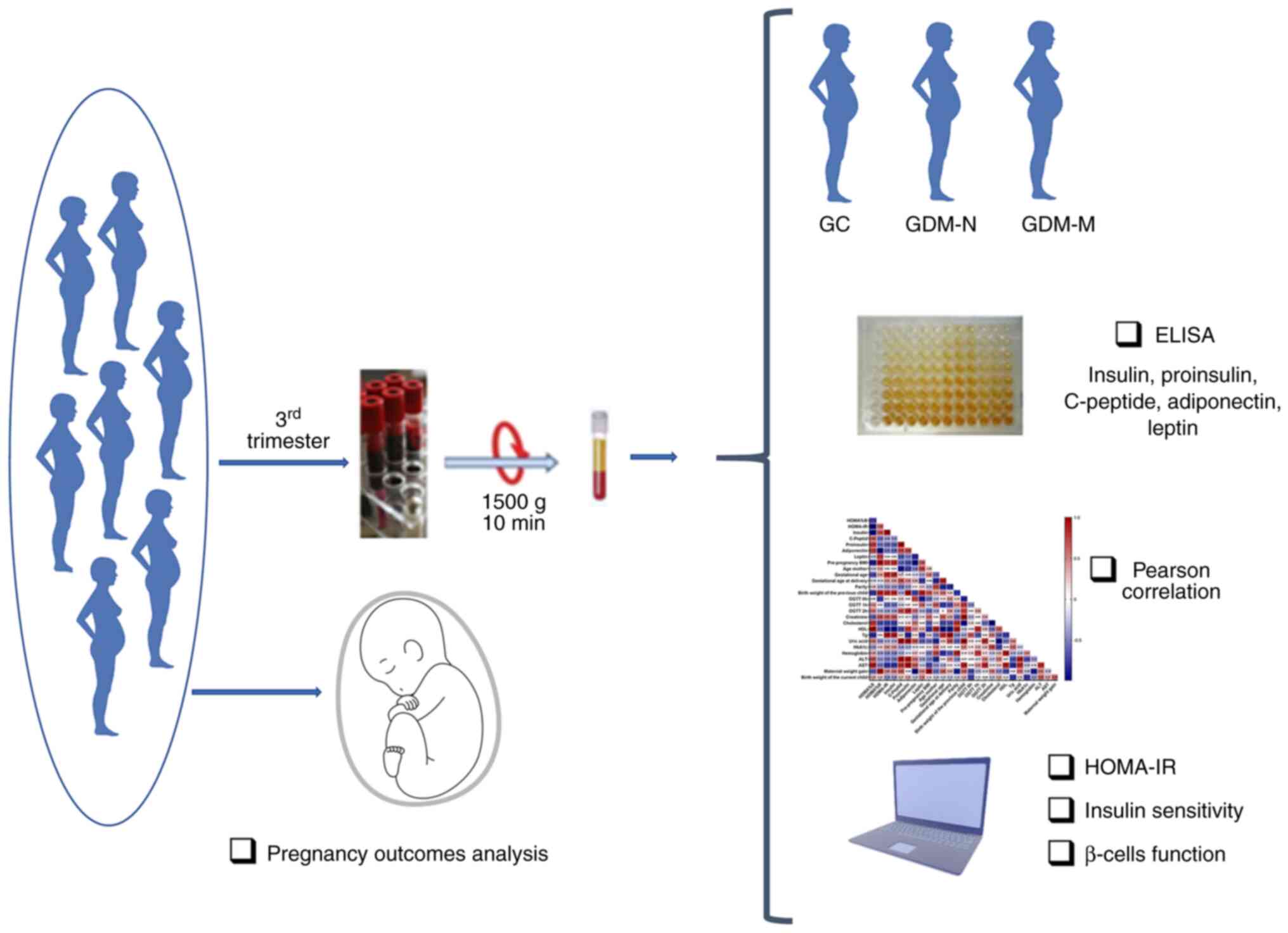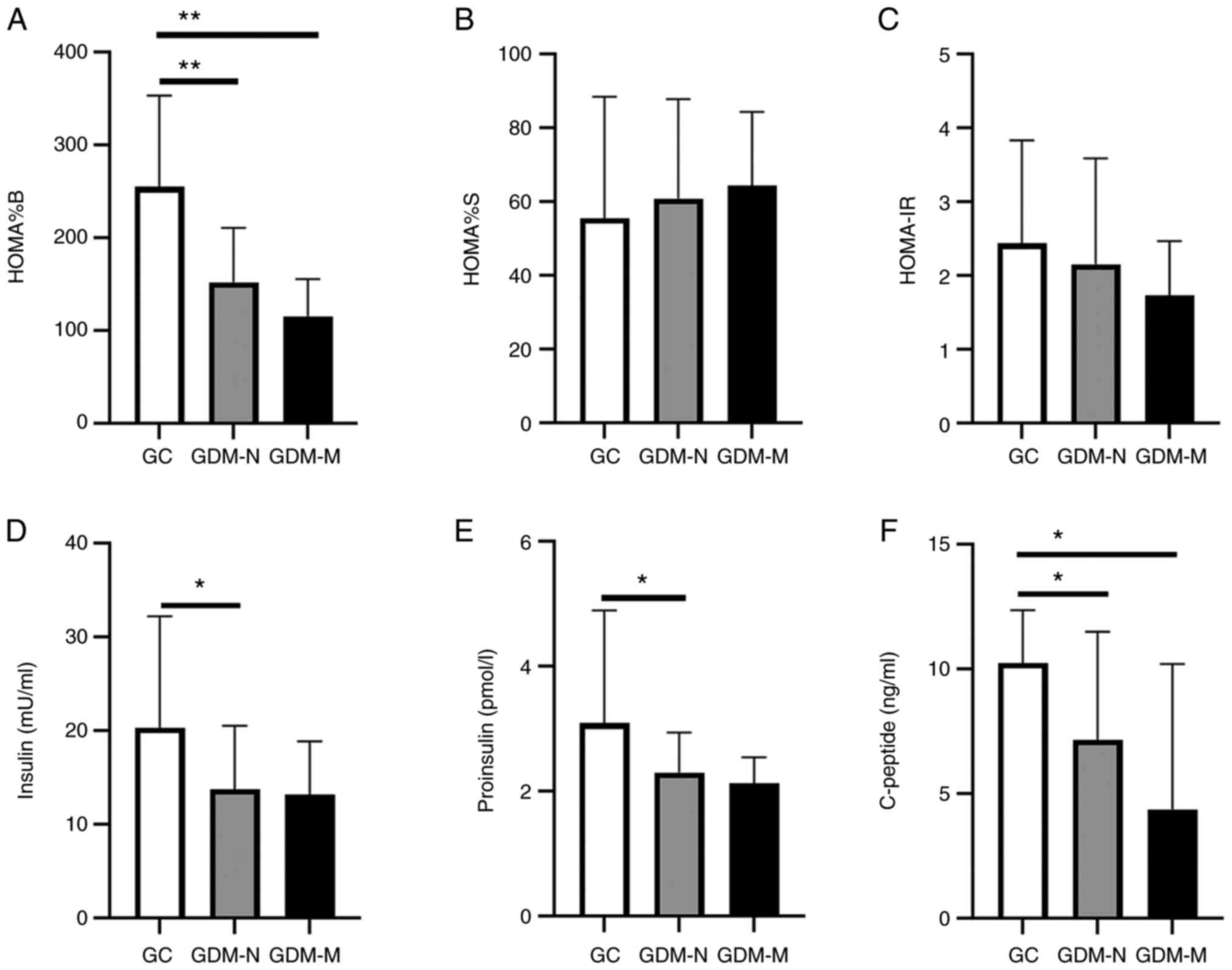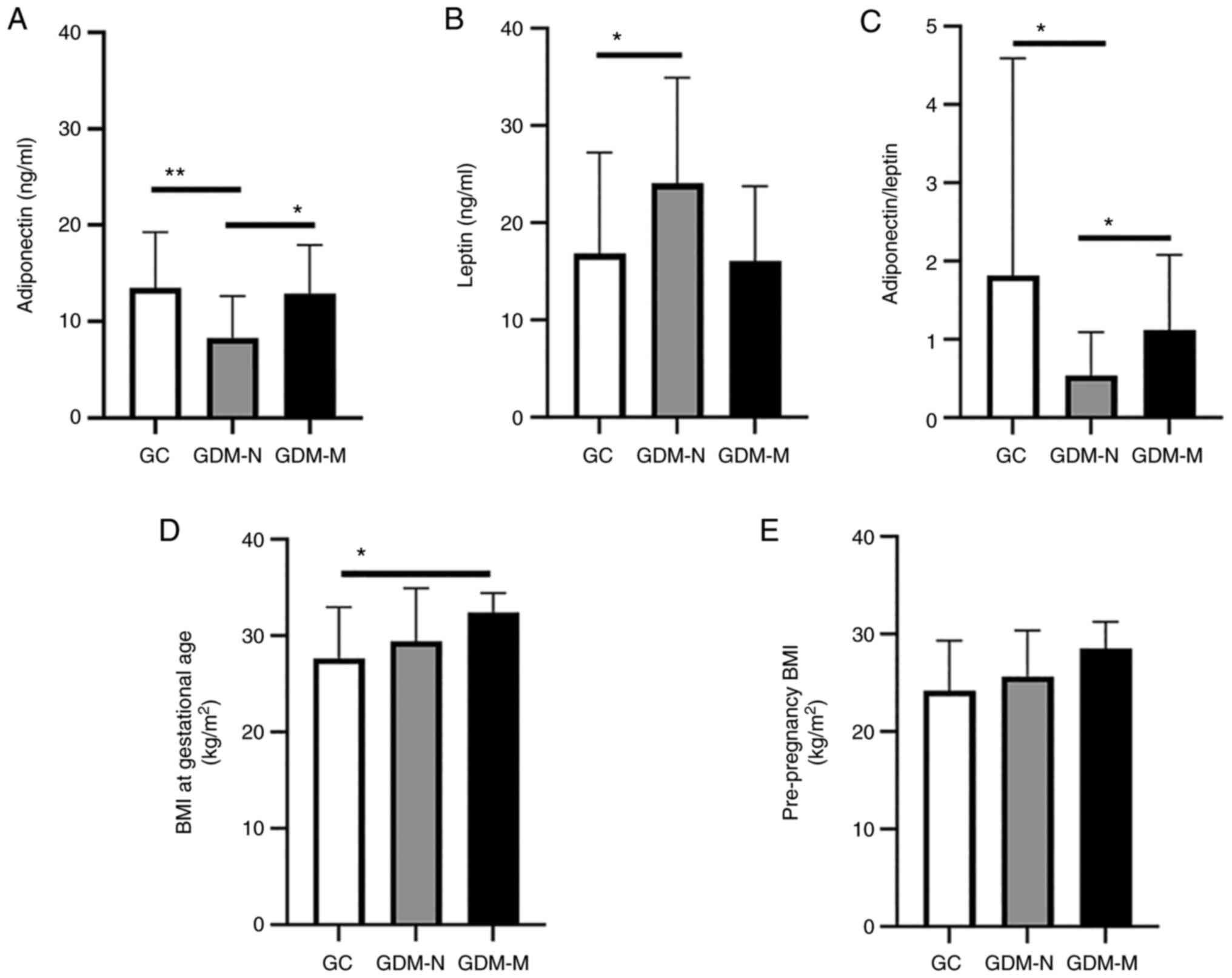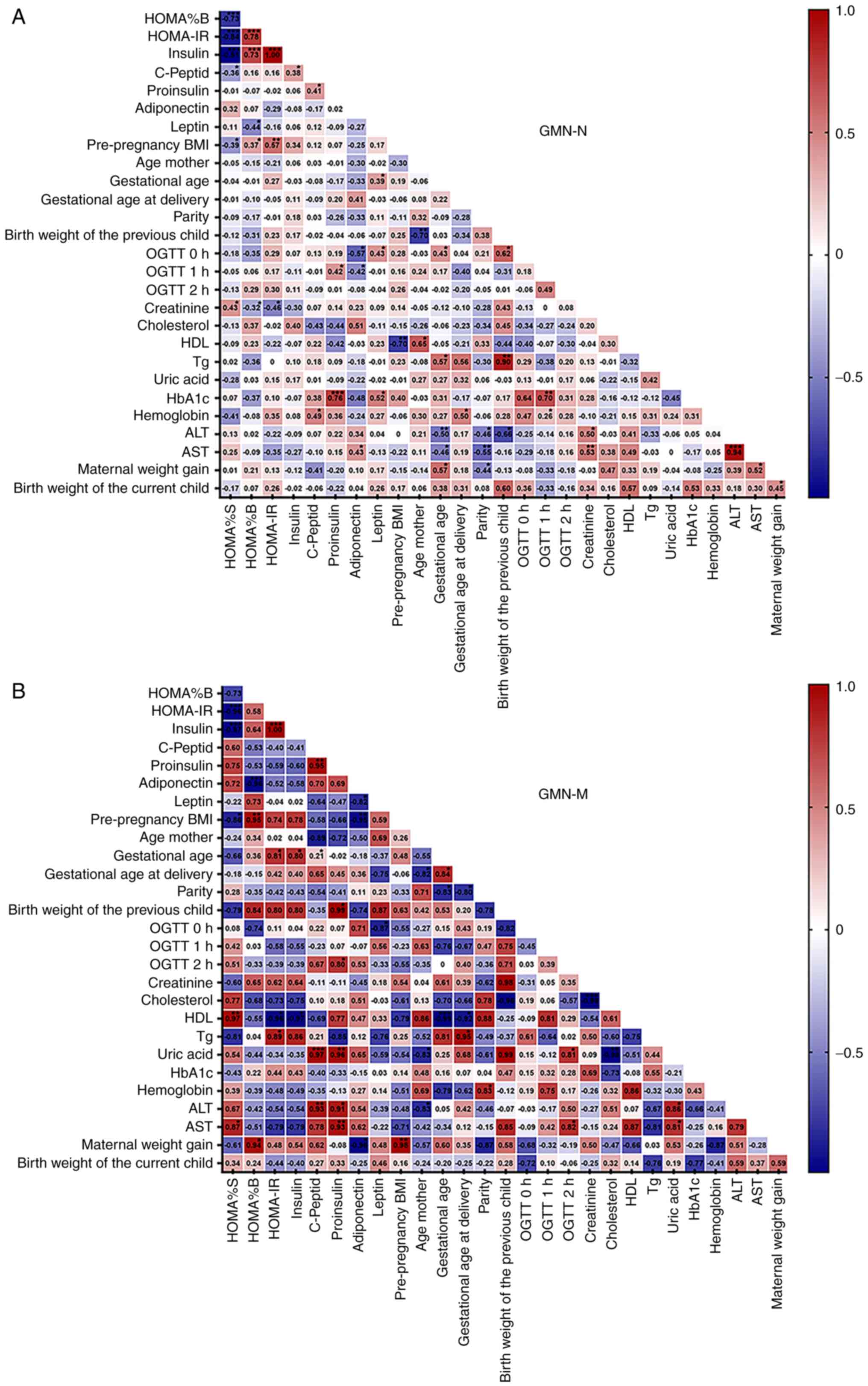|
1
|
American Diabetes Association Professional
Practice Committee. Draznin B, Aroda VR, Bakris G, Benson G, Brown
FM, Freeman R, Green J, Huang E, Isaacs D, et al: 15. Management of
diabetes in pregnancy: Standards of medical care in diabetes-2022.
Diabetes Care. 45 (Suppl 1):S232–S243. 2022.PubMed/NCBI View Article : Google Scholar
|
|
2
|
Cho NH, Shaw JE, Karuranga S, Huang Y, da
Rocha Fernandes JD, Ohlrogge AW and Malanda B: IDF diabetes atlas:
Global estimates of diabetes prevalence for 2017 and projections
for 2045. Diabetes Res Clin Pract. 138:271–281. 2018.PubMed/NCBI View Article : Google Scholar
|
|
3
|
Buchanan TA, Xiang AH and Page KA:
Gestational diabetes mellitus: Risks and management during and
after pregnancy. Nat Rev Endocrinol. 8:639–649. 2012.PubMed/NCBI View Article : Google Scholar
|
|
4
|
Catalano PM: Trying to understand
gestational diabetes. Diabet Med. 31:273–281. 2014.PubMed/NCBI View Article : Google Scholar
|
|
5
|
Van Assche FA, Aerts L and De Prins F: A
morphological study of the endocrine pancreas in human pregnancy.
Br J Obstet Gynaecol. 85:818–820. 1978.PubMed/NCBI View Article : Google Scholar
|
|
6
|
Plows JF, Stanley JL, Baker PN, Reynolds
CM and Vickers MH: The pathophysiology of gestational diabetes
mellitus. Int J Mol Sci. 19(3342)2018.PubMed/NCBI View Article : Google Scholar
|
|
7
|
Barbour LA, McCurdy CE, Hernandez TL,
Kirwan JP, Catalano PM and Friedman JE: Cellular mechanisms for
insulin resistance in normal pregnancy and gestational diabetes.
Diabetes Care. 30 (Suppl 2):S112–S119. 2007.PubMed/NCBI View Article : Google Scholar
|
|
8
|
Paganoti CF, da Costa RA, Oliveira AMDSS,
Hoshida MS and Francisco RPV: Adiponectin does not improve the
prediction of insulin need in pregnant women with gestational
diabetes mellitus. Endocrine and Metabolic Science.
3(100095)2021.
|
|
9
|
Lihn AS, Pedersen SB and Richelsen B:
Adiponectin: Action, regulation and association to insulin
sensitivity. Obes Rev. 6:13–21. 2005.PubMed/NCBI View Article : Google Scholar
|
|
10
|
Zavalza-Gómez AB, Anaya-Prado R,
Rincón-Sánchez AR and Mora-Martínez JM: Adipokines and insulin
resistance during pregnancy. Diabetes Res Clin Pract. 80:8–15.
2008.PubMed/NCBI View Article : Google Scholar
|
|
11
|
Powe CE, Allard C, Battista MC, Doyon M,
Bouchard L, Ecker JL, Perron P, Florez JC, Thadhani R and Hivert
MF: Heterogeneous contribution of insulin sensitivity and secretion
defects to gestational diabetes mellitus. Diabetes Care.
39:1052–1055. 2016.PubMed/NCBI View Article : Google Scholar
|
|
12
|
Iikuni N, Lam QL, Lu L, Matarese G and La
Cava A: Leptin and inflammation. Curr Immunol Rev. 4:70–79.
2008.PubMed/NCBI View Article : Google Scholar
|
|
13
|
Kc K, Shakya S and Zhang H: Gestational
diabetes mellitus and macrosomia: A literature review. Ann Nutr
Metab. 66 (Suppl 2):S14–S20. 2015.PubMed/NCBI View Article : Google Scholar
|
|
14
|
Herath RP, Siriwardana SR, Ekanayake CD,
Abeysekara V, Kodithuwakku SUA and Herath HP: Non-alcoholic fatty
liver disease and pregnancy complications among Sri Lankan women: A
cross sectional analytical study. PLoS One.
14(e0215326)2019.PubMed/NCBI View Article : Google Scholar
|
|
15
|
Yarrington CD, Cantonwine DE, Seely EW,
McElrath TF and Zera CA: The association of early unexplained
elevated alanine aminotransferase with large-for-gestational-age
birthweight. Am J Obstet Gynecol. 215:e471–e475. 2016.PubMed/NCBI View Article : Google Scholar
|
|
16
|
Crowther CA, Hiller JE, Moss JR, McPhee
AJ, Jeffries WS and Robinson JS: Effect of treatment of gestational
diabetes mellitus on pregnancy outcomes. N Engl J Med.
352:2477–2486. 2005.PubMed/NCBI View Article : Google Scholar
|
|
17
|
Hoegsberg B, Gruppuso PA and Coustan DR:
Hyperinsulinemia in macrosomic infants of nondiabetic mothers.
Diabetes Care. 16:32–36. 1993.PubMed/NCBI View Article : Google Scholar
|
|
18
|
Institute of Medicine (US) and National
Research Council (US) Committee to Reexamine IOM Pregnancy Weight
Guidelines: Weight gain during pregnancy: Reexamining the
guidelines. Rasmussen KM and Yaktine AL (eds). National Academies
Press (US), Washington, DC, 2009.
|
|
19
|
APGAR V: A proposal for a new method of
evaluation of the newborn infant. Curr Res Anesth Analg.
32:260–267. 1953.PubMed/NCBI
|
|
20
|
National Institute for Health and Care
Excellence: Guidelines. National Institute for Health and Care
Excellence (NICE), London, 2003.
|
|
21
|
Wallace TM, Levy JC and Matthews DR: Use
and abuse of HOMA modelling. Diabetes Care. 27:1487–1495.
2004.PubMed/NCBI View Article : Google Scholar
|
|
22
|
Ezenwaka CE, Kalloo R, Uhlig M, Schwenk R
and Eckel J: Serum adiponectin levels and enzyme markers of liver
dysfunction in diabetic and non-diabetic caribbean subjects. Br J
Biomed Sci. 63:117–122. 2006.PubMed/NCBI View Article : Google Scholar
|
|
23
|
Antwi J, Proulx W, Sullivan S, Lavin R and
Bellavia M: Serum Leptin is associated with fasting plasma glucose
and serum insulin levels independent of PI in Haitian Americans
with type 2 diabetes. FASEB J. 32(670.9)2018.
|
|
24
|
Jin WY, Lin SL, Hou RL, Chen XY, Han T,
Jin Y, Tang L, Zhu ZW and Zhao ZY: Associations between maternal
lipid profile and pregnancy complications and perinatal outcomes: A
population-based study from China. BMC Pregnancy Childbirth.
16(60)2016.PubMed/NCBI View Article : Google Scholar
|
|
25
|
Retnakaran R, Ye C, Hanley AJ, Connelly
PW, Sermer M, Zinman B and Hamilton JK: Effect of maternal weight,
adipokines, glucose intolerance and lipids on infant birth weight
among women without gestational diabetes mellitus. CMAJ.
184:1353–1360. 2012.PubMed/NCBI View Article : Google Scholar
|
|
26
|
Wang J, Li Z and Lin L: Maternal lipid
profiles in women with and without gestational diabetes mellitus.
Medicine (Baltimore). 98(e15320)2019.PubMed/NCBI View Article : Google Scholar
|
|
27
|
Liu D, Wu L and Gao X: Changes of insulin
and C-peptide in pregnancy of gestational diabetes mellitus.
Zhonghua Fu Chan Ke Za Zhi. 34:717–719. 1999.PubMed/NCBI(In Chinese).
|
|
28
|
Sarkar M, Grab J, Dodge JL, Gunderson EP,
Rubin J, Irani RA, Cedars M and Terrault N: Non-alcoholic fatty
liver disease in pregnancy is associated with adverse maternal and
perinatal outcomes. J Hepatol. 73:516–522. 2020.PubMed/NCBI View Article : Google Scholar
|
|
29
|
Atsawarungruangkit A, Chenbhanich J and
Dickstein C: C-peptide as a key risk factor for non-alcoholic fatty
liver disease in the United States population. World J
Gastroenterol. 24:3663–3670. 2018.PubMed/NCBI View Article : Google Scholar
|
|
30
|
Festa A, Shnawa N, Schernthaner G and
Haffner SM: Proinsulin in pregnant women with normal glucose
tolerance or mild gestational diabetes mellitus. Exp Clin
Endocrinol Diabetes. 107:447–452. 1999.PubMed/NCBI View Article : Google Scholar
|
|
31
|
Ardigo D, Numeroso F, Valtuena S, Franzini
L, Piatti PM, Monti L, Delsignore R, Reaven GM and Zavaroni I:
Hyperinsulinemia predicts hepatic fat content in healthy
individuals with normal transaminase concentrations. Metabolism.
54:1566–1570. 2005.PubMed/NCBI View Article : Google Scholar
|
|
32
|
Caballeria L, Pera G, Auladell MA, Toran
P, Munoz L, Miranda D, Aluma A, Casas JD, Sanchez C, Gil D, et al:
Prevalence and factors associated with the presence of nonalcoholic
fatty liver disease in an adult population in Spain. Eur J
Gastroenterol Hepatol. 22:24–32. 2010.PubMed/NCBI View Article : Google Scholar
|
|
33
|
Bajaj S, Nigam P, Luthra A, Pandey RM,
Kondal D, Bhatt SP, Wasir JS and Misra A: A case-control study on
insulin resistance, metabolic co-variates & prediction score in
non-alcoholic fatty liver disease. Indian J Med Res. 129:285–292.
2009.PubMed/NCBI
|
|
34
|
Morton GJ, Cummings DE, Baskin DG, Barsh
GS and Schwartz MW: Central nervous system control of food intake
and body weight. Nature. 443:289–295. 2006.PubMed/NCBI View Article : Google Scholar
|
|
35
|
Thorens B, Guillam MT, Beermann F,
Burcelin R and Jaquet M: Transgenic reexpression of GLUT1 or GLUT2
in pancreatic β cells rescues GLUT2-null mice from early death and
restores normal glucose-stimulated insulin secretion. J Biol Chem.
275:23751–23758. 2000.PubMed/NCBI View Article : Google Scholar
|
|
36
|
Tsai PJ, Yu CH, Hsu SP, Lee YH, Huang IT,
Ho SC and Chu CH: Maternal plasma adiponectin concentrations at 24
to 31 weeks of gestation: Negative association with gestational
diabetes mellitus. Nutrition. 21:1095–1099. 2005.PubMed/NCBI View Article : Google Scholar
|
|
37
|
Cseh K, Baranyi E, Melczer Z, Kaszás E,
Palik E and Winkler G: Plasma adiponectin and pregnancy-induced
insulin resistance. Diabetes Care. 27:274–275. 2004.PubMed/NCBI View Article : Google Scholar
|
|
38
|
Zhu Y, Hedderson MM, Quesenberry CP, Feng
J and Ferrara A: Liver enzymes in early to mid-pregnancy, insulin
resistance, and gestational diabetes risk: A longitudinal analysis.
Front Endocrinol (Lausanne). 9(581)2018.PubMed/NCBI View Article : Google Scholar
|
|
39
|
Fraser A, Harris R, Sattar N, Ebrahim S,
Smith GD and Lawlor DA: Alanine aminotransferase,
gamma-glutamyltransferase and incident diabetes: The british
Women's heart and health study and meta-analysis. Diabetes Care.
32:741–750. 2009.PubMed/NCBI View Article : Google Scholar
|
|
40
|
Ruhl CE and Everhart JE: Elevated serum
alanine aminotransferase and gamma-glutamyltransferase and
mortality in the United States population. Gastroenterology.
136:477–485.e11. 2009.PubMed/NCBI View Article : Google Scholar
|
|
41
|
Kunutsor SK, Apekey TA and Walley J: Liver
aminotransferases and risk of incident type 2 diabetes: a
systematic review and meta-analysis. Am J Epidemiol. 178:159–171.
2013.PubMed/NCBI View Article : Google Scholar
|
|
42
|
Bacq Y: The liver in normal pregnancy. In:
Madame Curie Bioscience Database. Landes Bioscience, Austin, TX,
2000-2013.
|
|
43
|
Song S, Zhang Y, Qiao X, Duo Y, Xu J, Peng
Z, Zhang J, Chen Y, Nie X, Sun Q, et al: ALT/AST as an independent
risk factor of gestational diabetes mellitus compared with
TG/HDL-C. Int J Gen Med. 15:115–121. 2022.PubMed/NCBI View Article : Google Scholar
|
|
44
|
Wiznitzer A, Furman B, Zuili I, Shany S,
Reece EA and Mazor M: Cord leptin level and fetal macrosomia.
Obstet Gynecol. 96:707–713. 2000.PubMed/NCBI View Article : Google Scholar
|
|
45
|
Lee YS, Cho YK, Pae JC, Oh SY, Kang MS,
Park JH, Kim HJ, Park DI, Sohn CI, Jeon WK, et al: The relationship
between serum adiponectin level and serum alanine aminotransferase
elevation in Korean male with nonalcoholic fatty liver disease.
Korean J Hepatol. 12:221–229. 2006.PubMed/NCBI(In Ko).
|
|
46
|
Kazumi T, Kawaguchi A, Hirano T and
Yoshino G: Serum alanine aminotransferase is associated with serum
adiponectin, C-reactive protein and apolipoprotein B in young
healthy men. Horm Metab Res. 38:119–124. 2006.PubMed/NCBI View Article : Google Scholar
|
|
47
|
Vitoratos N, Salamalekis E, Kassanos D,
Loghis C, Panayotopoulos N, Kouskouni E and Creatsas G: Maternal
plasma leptin levels and their relationship to insulin and glucose
in gestational-onset diabetes. Gynecol Obstet Invest. 51:17–21.
2001.PubMed/NCBI View Article : Google Scholar
|
|
48
|
Thagaard IN, Krebs L, Holm JC, Lange T,
Larsen T and Christiansen M: Adiponectin and leptin as first
trimester markers for gestational diabetes mellitus: A cohort
study. Clin Chem Lab Med. 55:1805–1812. 2017.PubMed/NCBI View Article : Google Scholar
|
|
49
|
Kautzky-Willer A, Pacini G, Tura A,
Bieglmayer C, Schneider B, Ludvik B, Prager R and Waldhäusl W:
Increased plasma leptin in gestational diabetes. Diabetologia.
44:164–172. 2001.PubMed/NCBI View Article : Google Scholar
|
|
50
|
Sacks DA: Etiology, detection and
management of fetal macrosomia in pregnancies complicated by
diabetes mellitus. Clin Obstet Gynecol. 50:980–989. 2007.PubMed/NCBI View Article : Google Scholar
|
|
51
|
Miao M, Dai M, Zhang Y, Sun F, Guo X and
Sun G: Influence of maternal overweight, obesity and gestational
weight gain on the perinatal outcomes in women with gestational
diabetes mellitus. Sci Rep. 7(305)2017.PubMed/NCBI View Article : Google Scholar
|
|
52
|
Hill B, Bergmeier H, McPhie S,
Fuller-Tyszkiewicz M, Teede H, Forster D, Spiliotis BE, Hills AP
and Skouteris H: Is parity a risk factor for excessive weight gain
during pregnancy and postpartum weight retention? A systematic
review and meta-analysis. Obes Rev. 18:755–764. 2017.PubMed/NCBI View Article : Google Scholar
|
|
53
|
Harris HE, Ellison GT and Holliday M: Is
there an independent association between parity and maternal weight
gain? Ann Hum Biol. 24:507–519. 1997.PubMed/NCBI View Article : Google Scholar
|
|
54
|
Ushida T, Kotani T, Kinoshita F, Imai K,
Nakano-Kobayashi T, Nakamura N, Moriyama Y, Yoshida S, Yamashita M
and Kajiyama H: Liver transaminase levels during pregnancy: A
Japanese multicenter study. J Matern Fetal Neonatal Med. 28:1–7.
2021.PubMed/NCBI View Article : Google Scholar
|
|
55
|
Lin J, Jin H and Chen L: Associations
between insulin resistance and adverse pregnancy outcomes in women
with gestational diabetes mellitus: A retrospective study. BMC
Pregnancy Childbirth. 21(526)2021.PubMed/NCBI View Article : Google Scholar
|
|
56
|
Catalano PM, Kirwan JP, Haugel-de Mouzon S
and King J: Gestational diabetes and insulin resistance: Role in
short- and long-term implications for mother and fetus. J Nutr. 133
(5 Suppl 2):1674S–1683S. 2003.PubMed/NCBI View Article : Google Scholar
|
|
57
|
VanWiden K, Montoro M, Korst LM and
Ouzounian JG: A homeostatic model assessment of insulin resistance
(HOMA-IR) relates to gestational diabetes, glycemic control. Obstet
Gynecol. 129(112S)2017.
|
|
58
|
Cacho J, Sevillano J, de Castro J, Herrera
E and Ramos MP: Validation of simple indexes to assess insulin
sensitivity during pregnancy in Wistar and Sprague-Dawley rats. Am
J Physiol Endocrinol Metab. 295:1269–1276. 2008.PubMed/NCBI View Article : Google Scholar
|
|
59
|
Knopp RH, Chapman M, Bergelin RO, Wahl PW,
Warth MR and Irvine S: Relationship of lipoprotein lipids to mild
fasting hyperglycemia and diabetes in pregnancy. Diabetes Care.
3:416–420. 1980.PubMed/NCBI View Article : Google Scholar
|


















